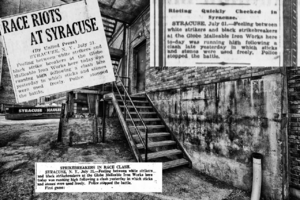Syracuse riot of 1919 facts for kids
| Part of Red Summer | |

News coverage of the Syracuse riot of 1919
|
|
| Date | July 31, 1919 |
|---|---|
| Location | Syracuse, New York, United States |
The Syracuse riot of 1919 was a serious conflict that happened in Syracuse, New York, on July 31, 1919. It involved white workers who were on strike and Black workers who were hired to replace them. This event was part of a larger period of unrest called the Red Summer.
Contents
What Was Happening Across America?
After World War I, many white workers in America were facing tough working conditions. They often went on strike to ask for better pay and safer jobs. At the same time, many Black Americans were moving from the Southern states to cities in the North and Midwest. This big move was called the Great Migration.
Jobs and Unions
Most worker groups, called unions, did not include Black Americans. This meant Black workers often couldn't get the better-paying union jobs. When white workers went on strike, big companies sometimes hired Black laborers to keep their factories running. These replacement workers were called strikebreakers.
Companies did this to avoid paying their striking workers more money. They also hoped to cause conflict between the two groups of workers. This strategy was used across the country. It led to many clashes between white workers and Black strikebreakers. The Syracuse riot was one example of these conflicts.
The Syracuse Riot Begins
The Globe Malleable Iron Works in Syracuse, New York, made metal products. In the summer of 1919, the Polish and Italian workers who shaped the metal went on strike. To try and end the strike, the factory owners hired Black workers to take their place.
The Conflict at the Factory
This decision led to a violent clash between the striking workers and the new Black workers. The strikers caused damage to the property of the strikebreakers. City officials had to call in the entire police force to stop the fighting. Several white men were arrested during the riot.
The Red Summer of 1919
The Syracuse riot was one of many similar events that happened in 1919. This period is known as the Red Summer. During this time, there were many attacks on Black communities across the United States. In most cases, large groups of white people attacked Black neighborhoods.
Resisting Attacks
Sometimes, Black community groups fought back against these attacks. This happened in cities like Chicago and Washington, D.C.. Many people were hurt or killed during the Red Summer. The Elaine massacre in Arkansas was one of the deadliest events.
Other major events included the Chicago race riot of 1919 and the Washington race riot of 1919. These riots caused many injuries and a lot of property damage. The Red Summer was a difficult time in American history. It showed the serious racial tensions that existed after World War I.

